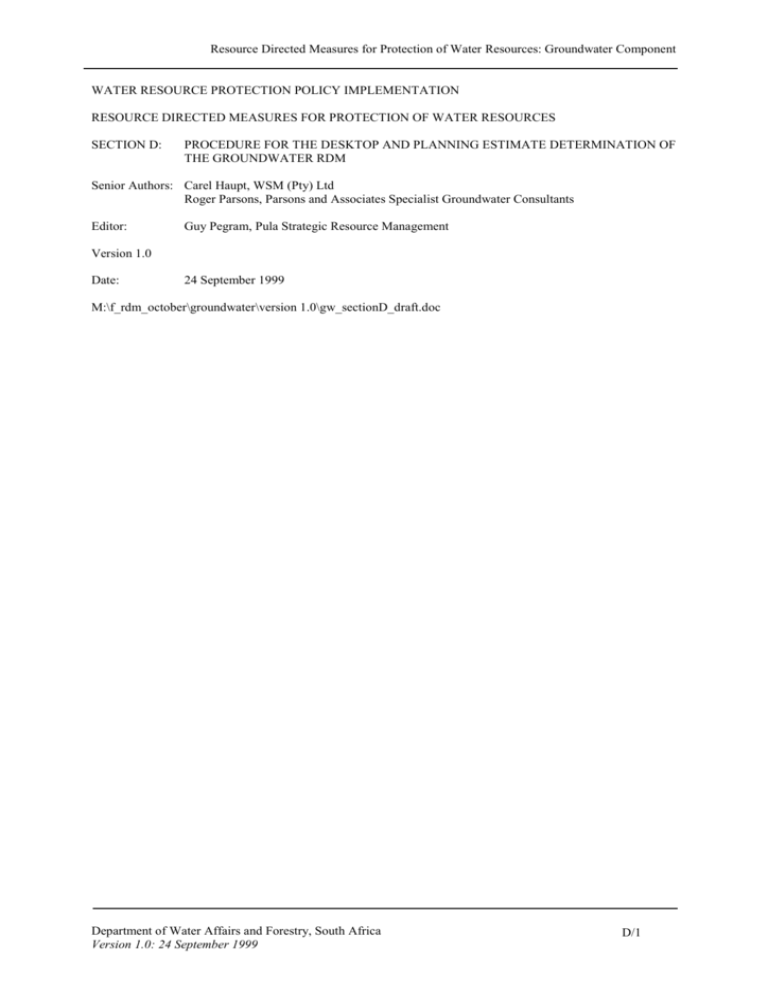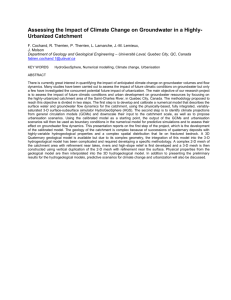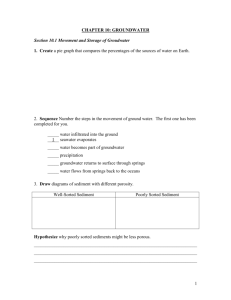SECTION D:
advertisement

Resource Directed Measures for Protection of Water Resources: Groundwater Component WATER RESOURCE PROTECTION POLICY IMPLEMENTATION RESOURCE DIRECTED MEASURES FOR PROTECTION OF WATER RESOURCES SECTION D: PROCEDURE FOR THE DESKTOP AND PLANNING ESTIMATE DETERMINATION OF THE GROUNDWATER RDM Senior Authors: Carel Haupt, WSM (Pty) Ltd Roger Parsons, Parsons and Associates Specialist Groundwater Consultants Editor: Guy Pegram, Pula Strategic Resource Management Version 1.0 Date: 24 September 1999 M:\f_rdm_october\groundwater\version 1.0\gw_sectionD_draft.doc Department of Water Affairs and Forestry, South Africa Version 1.0: 24 September 1999 D/1 Resource Directed Measures for Protection of Water Resources: Groundwater Component Section D: Procedure for the Desktop and Planning Estimate Determination of the Groundwater Component of Resource Directed Measures D.1 Preamble The Department of Water Affairs and Forestry (DWAF) initiated the Water Resources Situation Study (WRSS) to provide a broad overview of national and provincial water requirements and water resources available to meet these requirements. This information is to be used to assist decision making related to long-term water resource planning. The study covers the whole of South Africa, but information will be collated on a quaternary catchment basis. Available information is being used and will facilitate reconnaissance level estimates being made of both water requirements and available resources. The WRSS formed the basis of both the Desktop and Rapid Reserve Determination methods. These are preliminary methods used to set the Reserve (as defined in the National Water Act, Act No. 36 of 1998). By definition, Reserve determinations using the Desktop and Rapid methods should take approximately 2 hours and 2 days to complete respectively. Further, such estimates would typically have ‘very low’ to ‘low’ levels of confidence. It was recognised at the outset of the WRSS that water resources comprise both surface and groundwater. WSM (Pty) Ltd were appointed to develop methods and tools to facilitate quantification of groundwater resources (Haupt, 1999). The procedure described below is based on this work and is used for both the Desktop Reserve Determination (DRD) method and the Rapid Reserve Determination (RRD) method. D.2 Process of Reserve Determination The DRD and RRD methods differ from Intermediate Reserve Determinations (IRD) and Comprehensive Reserve Determinations (CRD) methods in that the generic seven step process of Reserve determinations is not closely followed (DWAF, 1999 – Volume 2). The main purpose of the DRD and RRD methods for determining the groundwater component of the Reserve is to quantify how much groundwater could be abstracted without impacting the Reserve using readily available information. Quaternary catchments were assumed to be significant water resources and therefore formed the basis of preliminary Reserve determinations. No process is specified for demarcation geohydrological regions or homogeneous response units. Similarly, no formal resource classification system is used. As very rapid tools, it was assumed no groundwater management corrective actions are required. In those instances where groundwater systems have been impacted, a CRD assessments will probably be required. The proposed process requires generic, conservative Resource Quality Objectives (RQO’s) be set (see Section D4). Though recognised that groundwater monitoring is required as part of the Reserve determination process, no monitoring requirements are specified by the DRD and RRD procedure. It was assumed this aspect will be addressed by the general authorisation and permitting processes. D.3 Method D.3.1 Basis Both DWAF and the Water Research Commission (WRC) recognised the need to prepare geohydrological maps of the country. A set of national maps were prepared by Vegter (1995) while DWAF concentrated on preparing a series regional scale maps. These maps in turn led to preparation and publication of the national groundwater harvest potential map of the Republic of South Africa (Seymour, 1995, Baron et al., 1998). Department of Water Affairs and Forestry, South Africa Version 1.0: 24 September 1999 D/2 Resource Directed Measures for Protection of Water Resources: Groundwater Component As these maps represent the best available national assessment of groundwater resources in the country, it was decided to base the groundwater component of the WRSS on these data sets (Haupt, 1999). It was also recognised that total water resources are not equivalent to a simple addition of available surface and groundwater resources nor does base flow account for all groundwater resources. As limited or no baseflow occurs in the drier western parts of South Africa, groundwater resources are both significant and important in these areas. A spreadsheet was developed by Haupt (1999) in which the sustainable volume of abstractable groundwater in each quaternary catchment was determined. This volume, referred to as the groundwater portion, is similar to the groundwater allocation used in the IRD method discussed in Section E. Because of the low level of confidence of the estimate, the estimates are conservative. The series of steps followed in determining the groundwater portion are briefly described below. D.3.2 Calculation Procedure The procedure used by Haupt (1999) to determine the groundwater portion of each quaternary catchment is recorded below to allow practioners the opportunity to evaluate both the methodology and the resultant assessment. To allow for comparison, the groundwater portion of the catchments used to test the IRD method (Section G1) are presented in Table 1. STEP1: Determine harvest potential of each quaternary catchment The harvest potential of each quaternary catchment was determined using information from the groundwater harvest potential map (Seymour, 1995; Baron, et al., 1998). Quaternary catchment boundaries were overlain on the harvest potential map and the harvest potential of each quaternary catchment calculated. It is important to recognise harvest potential is based on both recharge and aquifer storage criteria, with the limiting criterion being used to quantify the harvest potential of an area. STEP2: Determine the exploitation potential Because of economic and environmental considerations, it is not possible to abstract all groundwater recharged or stored in an aquifer system. The hydraulic conductivity of groundwater systems plays a major role in determining how much water can be abstracted. As regional information on hydraulic conductivity is not readily available, borehole yield information from the National Groundwater Database (NGDB) and the Water Services Database (WSDB) were used to determine the borehole yield factor (Table D1) as a strong relationship exists between borehole yield and hydraulic conductivity. Table D1: Determination of the Borehole Yield Factor Average Borehole Yield (L/s) >3.0 L/s 1.5 - 3.0 L/s 0.7 - 1.5 L/s 0.3 - 0.7 L/s <0.3 L/s Borehole Factor Yield 0.7 0.6 0.5 0.4 0.3 The average borehole yield for each quaternary catchment was determined and, using Table 1, the borehole yield factor determined. The harvest potential of each catchment (Step 1) was then multiplied by the corresponding borehole yield factor to obtain an exploitation potential. Exploitation potential is a measure of the volume of groundwater that realistically can be abstracted from the catchment. STEP 3: Determine base flow contribution In some areas groundwater contributes to the base flow of rivers (effluent river) while in other areas surface water recharges groundwater systems (influent river). If this relationship is not understood, it results in ‘double Department of Water Affairs and Forestry, South Africa Version 1.0: 24 September 1999 D/3 Resource Directed Measures for Protection of Water Resources: Groundwater Component accounting’ when determining the total water resource available for abstraction. To avoid this problem it was decided to subtract groundwater contribution to base flow from the harvest potential (Haupt, 1999). STEP 3a: Determine base flow Determine the 75th percentile of MAR of a catchment from WR90 daily flow duration curves. STEP 3b: Determine the base flow factor Divide the base flow of a catchment by it’s harvest potential. STEP 3c: Determine the corrected base flow If the base flow factor is less than 1, accept the determined base flow (Step 3a) as the corrected base flow. If the base flow factor is greater than 1, then divide the determined base flow (Step 3a) by the base flow factor and record the quotient as the corrected base flow STEP 4: Determine the groundwater portion The groundwater portion is determined by subtracting the corrected base flow (Step 3c) from the harvest potential (Step 1). The groundwater portion of a catchment is then considered to be the annual volume of groundwater that can be abstracted from a catchment on a sustainable basis without impacting the Reserve. D.3.3 Groundwater Portion Spreadsheet The spreadsheet (Table 2) in which the groundwater portion of each quaternary catchment will be recorded is currently being finalised (Haupt, 1999). Determination of the groundwater component of a DRD will merely require looking up in the spreadsheet the groundwater portion of the relevant catchment. A similar process is used when undertaking a RRD assessment, but a geohydrologist with local knowledge may be consulted regarding surface – groundwater interaction, present status and related issues. No geohydrological fieldwork will be possible. It must be recognised the spreadsheet is in its early stages of development and refinements will be required. In the eastern parts of the country which experience higher rainfall and where harvest potential is limited by storage (Seymour, 1995; Baron, et al., 1998) the groundwater portion appears inappropriate. Poor understanding of surface-groundwater interaction and the assumption that storage is a limiting factor in high rainfall areas (i.e. where the base flow factor is greater than 1) contribute to this. This problem needs to be addressed. D.4 Resource Quality Objectives RQO’s are set to ensure the integrity of the Reserve remains intact and provide resource management guidelines and performance specifications. Catchment specific conditions need to be considered when setting RQO’s. The timeframe allowed for the DRD and RRD methods, however, will in many cases preclude consideration of site specific information. The following generic RQO’s, therefore, are set as guidelines: the regional groundwater level in a quaternary catchment may not decline over the long-term; groundwater quality may not deteriorate and must remain in its ambient state; and groundwater abstraction may not impact river and spring flow, riparian or terrestrial vegetation nor land stability. If any of the above conditions are apparent in a quaternary catchment, the preliminary Reserve determination methods are invalid and a CRD assessment may be required. Department of Water Affairs and Forestry, South Africa Version 1.0: 24 September 1999 D/4 Resource Directed Measures for Protection of Water Resources: Groundwater Component D.5 Conclusion A methodology for quantifying the groundwater component and setting generic RQO’s as part of the DRD and RRD methods of determining the Reserve is proposed. The groundwater portion of a quaternary catchment is obtained from a spreadsheet currently being developed as part of the WRSS (Haupt, 1999). Though the spreadsheet was based on best available information, it still requires continual development and refinement. It is recommended a formal process be initiated to compare all estimates of the groundwater component of the Reserve to facilitate improvement of the DRD and RRD methods. Department of Water Affairs and Forestry, South Africa Version 1.0: 24 September 1999 D/5 Resource Directed Measures for Protection of Water Resources: Groundwater Component References Baron, J., Seward, P. and Seymour, A., 1999: The groundwater harvest potential map of the Republic of South Africa; Technical report Gh 3917, Directorate of Geohydrology, Department of Water Affairs and Forestry. Department of Water Affairs and Forestry, 1999: Resource directed measures for protection of water resources. Volume 1: Integration Manual Version 1.0, Department of Water Affairs and Forestry, Pretoria. Haupt, C., 1999: Water resources situation study - groundwater evaluation; document in preparation for the Department of Water Affairs and Forestry, WSM (Pty) Ltd, Pietersburg. Parsons, R.P., 1999: Intermediate Reserve determination method – a guide for quantifying the groundwater component; Beta Version report prepared for the Department of Water Affairs and Forestry, Parsons and Associates, Somerset West. Seymour, A., 1995: Explanation report for the groundwater harvest potential map of South Africa 1995, with notes on secondary aquifer system classification; Unpubl. provisional report, Department of Water Affairs and Forestry, Pretoria. Vegter, J.R., 1995: An explanation of a set of national groundwater maps; Report TT 74/95, Water Research Commission, Pretoria. Department of Water Affairs and Forestry, South Africa Version 1.0: 24 September 1999 D/6 Resource Directed Measures for Protection of Water Resources: Groundwater Component Table D2: Groundwater portion of selected quaternary catchment using the DRD method. QUATERNARY CATCHMENT AREA (km2) HARVEST POTENTIAL (x 106 m3/a) BASEFLOW (x 106 m3/a) CORRECTED BASEFLOW (x 106 m3/a) GROUNDWATER PORTION (x 106 m3/a) Pienaars River A23B A23C A23F A23G A23H A23J 817 493 566 954 1061 933 13.98 9.04 10.42 21.38 20.69 17.11 7.65 1.86 2.38 11.21 4.83 3.83 7.65 1.86 2.38 11.21 4.83 3.83 6.32 7.18 8.04 10.17 15.86 13.28 A23 total Atlantis 4824 92.62 31.76 31.76 60.85 G21B Graaff-Reinet 307 14.33 0.64 0.64 13.69 N13A 554 6.20 1.53 1.53 4.67 Note: This table excludes Step 2 as exploitation potential (as defined by Haupt, 1999) as no direct relevance to quantification of the Reserve is evident. The catchment used for N13A is larger than that used for the IRD case study (554 against 430 km 2). Department of Water Affairs and Forestry, South Africa Version 1.0: 24 September 1999 D/7







